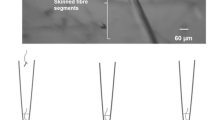Synopsis
Serial sections of longissimus dorsi and rectus femoris muscles from 15 Yorkshire breed pigs (live weights 24–46 and 94–139 kg) were stained for glycogen (PAS) and a mitochondrial enzyme (NAD tetrazolium reductase). Muscle fibres with a low mitochondrial content in both muscles were more frequently PAS-positive than fibres with a high or intermediate mitochondrial content. However, some pigs had all their muscle fibres PAS-positive while one pig with a highpost-mortem muscle pH had all rectus femoris fibres PAS-negative. Relative to lighter weight pigs, longissimus dorsi muscles of heavy pigs tended to have less fibres with a high mitochondrial content and less fibres with a positive PAS reaction. Compared to longissimus dorsi muscles, rectus femoris muscles had more fibres with a high mitochondrial content and less with a positive PAS reaction. All fibres in both muscles became PAS-negative with an accompanying decrease in pH by 24 hrpost-mortem. Fibres from longissimus dorsi musles frequently had PAS-positive sarcoplasmic cores between their myofibrils. Heavy pigs tended to have larger cores (up to a mean maximum diameter of 13.4 μm), more fibres with cores, and more cores per fibre. The pigs involved exhibited no otherante-orpost-mortem muscle abnormalities.
Similar content being viewed by others
References
Beecher, G. T., Kastenschmidt, L. L., Hoekstra, W. G., Cassens, R. G. &Briskey, E. J. (1969). Energy metabolites in red and white striated muscles of the pig.J. Agric. Fd Chem.,17, 29–33.
Bendall, J. R. (1973). Postmortem changes in muscle. In:The Structure and Function of Muscle (ed. G. H. Bourne), New York: Academic Press.
Bethlem, J. (1970).Muscle Pathology. Amsterdam. North-Holland.
Close, R. I. (1972). Dynamic properties of mammalian skeletal muscles.Physiol. Rev. 52, 129–97.
Dalrymple, R. H., Kastenschmidt, L. L. &Cassens, R. G. (1973). Glycogen and phophorylase in developing red and white muscle.Growth 37, 19–34.
Davies, A. S. (1972). Postnatal changes in the histochemical fibre types of porcine skeletal muscle.J. Anat. 113, 213–40.
Deutsch, K. &Done, J. T. (1971). Congenital myofibrillar hypoplasia of piglets: ultrastructure of affected fibres.Res. Vet. Sci. 12, 176–7.
Engel, W. K. &Brooke, M. H. (1967). Muscle biopsy as a clinical diagnostic aid. In:Neurological Diagnostic Techniques (ed. W. S. Fields). Springfield, Illinois, Charles C. Thomas.
Gillespie, C. A., Simpson, D. R. &Edgerton, Y. R. (1970). High glycogen content of red as opposed to white skeletal muscle fibres of guinea pigs.J. Histochem. Cytochem. 18, 552–8.
Guth, L. (1973). Fact and artifact in the histochemical procedure for myofibrillar ATPase.Exp. Neurol. 41, 440–50.
Guth, L. &Samaha, F. J. (1970). Procedure for the histochemical demonstration of actomyosin ATPase.Exp. Neurol. 28, 365–7.
Hale, L. J. (1965).Biological Laboratory Data, London: Science Paperbacks & Methuen.
Kastenschmidt, L. L., Hoekstra, W. G. &Briskey, E. J. (1968). Glycolytic intermediates and co-factors in ‘fast-’ and ‘slow-glycolyzing’ muscles of the pig.J. Fd. Sci. 33, 151–8.
Marple, D. N. &Cassens, R. G. (1973). A mechanism for stress-susceptibility in swine.J. Anim. Sci. 37, 546–50.
Mccance, R. A. &Widdowson, E. M. (1959). The effect of lowering the ambient temperature on the metabolism of the new-born pig.J. Physiol. Lond. 147, 124–34.
Moody, W. G. &Cassens, R. G. (1968). Histochemical differentiation of red and white muscle fibers.J. Anim. Sci. 27, 961–8.
Mount, L. E. (1968).The Climatic Physiology of the Pig. Baltimore: Williams and Wilkins.
Samaha, F. J. &Yunis, E. J. (1973). Quantitative and histochemical demonstration of a calcium activated mitochondrial ATPase in skeletal muscle.Exp. Neurol. 41, 431–9.
Shelley, H. J. (1961). Glycogen reserves and their changes at birth and in anoxia.Br. med. Bull. 17, 137–43.
Sink, J. D. &Judge, M. D. (1971). Age and breed effects on the biochemistry of porcine muscle growth.Growth 35, 349–57.
Swatland, H. J. (1975a). Histochemical development of myofibres in neonatal piglets.Res. Vet. Sci. 18, 253–57.
Swatland, H. J. (1975b). Relationships between mitochondrial content of muscle fibres and patterns of glycogen depletion post-mortem.Histochem. J. 7, 367–74.
Swatland, H. J. &Cassens, R. G. (1973). Observations on the postmortem histochemistry of myofibres from stress-susceptible pigs.J. Anim. Sci. 37, 885–91.
Thurley, D. C., Gilbert, F. R. &Done, J. T. (1967). Congenital splayleg of piglets: Myofibrillar hypoplasia.Vet. Rec. 80, 302–4.
van den Hende, C., Muylle, E., Oyaert, W. &de Roose, P. (1972). Changes in muscle characteristics in growing pigs. Histochemical and electron microscopic study.Zentbl. Vet. Med. 19, 102–10.
Author information
Authors and Affiliations
Rights and permissions
About this article
Cite this article
Swatland, H.J. Relationships between mitochondrial content and glycogen distribution in porcine muscle fibres. Histochem J 7, 459–469 (1975). https://doi.org/10.1007/BF01003883
Received:
Issue Date:
DOI: https://doi.org/10.1007/BF01003883




